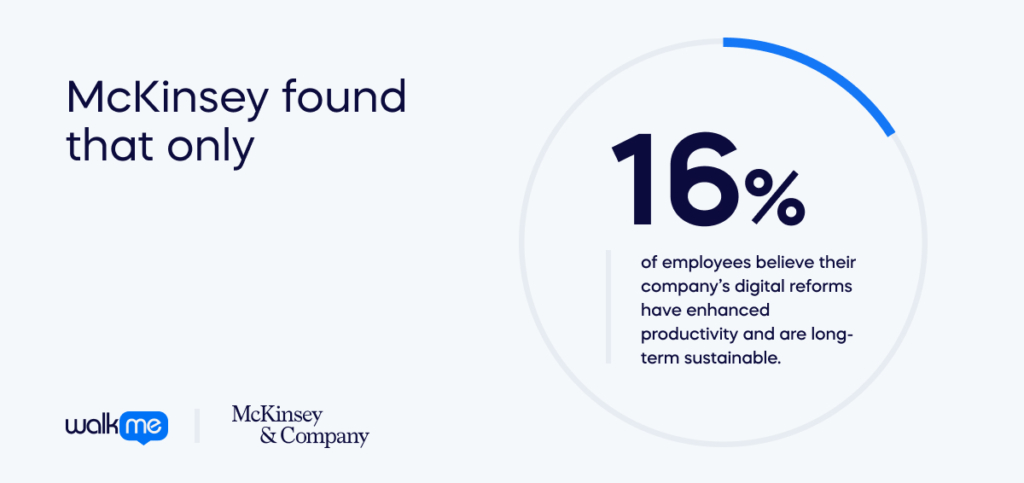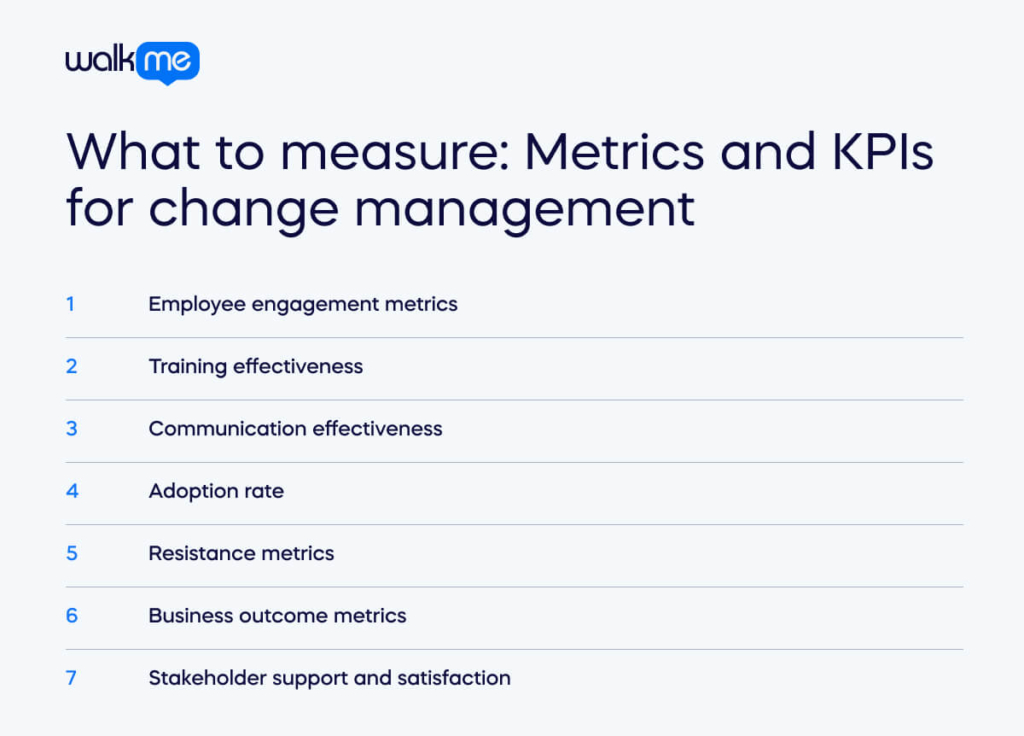There are two kinds of change in business.
Change you make to keep up with competitors.
And changes you make to get ahead.
If you want to drive business results, you need to make more of the latter kind of change.
But if you’re going to do that, you must be able to measure the impact of your change management.
Doing so helps you:
- Gain insight into the performance of an initiative.
- Demonstrate the ROI of a change initiative to stakeholders.
- Make adjustments, refine your method, and identify growth opportunities.
Measuring change management is a fundamental step in the change management process.
But,
What are you supposed to measure?
And how are you supposed to measure it?
In this article, we’re answering these two crucial questions and more.
We’re covering everything you need to know about how to measure change management. If you’ve been doing change management for a while but want to take your game to the next level, this is for you.
Why you need to measure change management
We’ve touched on a few of the benefits of measuring change management already, but the reasons for engaging in this practice extend far beyond that.
Measuring change management can actually help you address many of the challenges you’ll face as a change manager.
Consider this:
In 2021, Forbes reported that despite aligned leadership, 70% of digital transformation projects fall short of their goals. Our own research corroborates this, showing that only 34% of change initiatives succeed.
Years of poor change management can have an adverse impact on your employees too.

McKinsey found that only 16% of employees believe their company’s digital reforms have enhanced productivity and are long-term sustainable.
So, while a third of change initiatives are considered successful by leadership, only a sixth are considered successful by employees.
The result?
A 2022 Gartner report showed that between 2017 and 2022, the percentage of employees willing to support organizational change had shrunk from 74% to 38%.
The bottom line is this:
If you want to deliver better changes, you need to measure what you’re doing right, show people, and get them on your side.
Doing so will make your job easier, please stakeholders, improve employee experience, and make you a better change manager.
What to measure: Metrics and KPIs for change management

Without metrics and Key Performance Indicators (KPIs), it becomes challenging to gauge the effectiveness of your efforts and make necessary adjustments.
Measuring metrics and KPIs gives you a clearer picture of your change management’s efficacy.
It empowers you to make data-driven decisions, ensuring your change initiatives are always aligned with your organization’s goals and the well-being of your employees.
Here are 7 key metrics to measure change management and a few accompanying KPIs.
1. Employee engagement metrics:
- Surveys and feedback: Regular surveys assess how engaged and informed your employees feel during the change process.
- Participation rate: Monitor how many employees participate in change-related training sessions or workshops.
2. Training effectiveness:
- Knowledge retention: Assess employees post-training to determine what information was retained.
- Application of skills: Measure how effectively the trained skills are applied in real-world scenarios.
3. Communication effectiveness:
- Feedback loops: Track the frequency and effectiveness of feedback mechanisms.
- Message penetration: Evaluate how well and far your communication about the change reaches within the organization.
4. Adoption rate:
- Usage metrics: Monitor the usage rate of new systems or tools for technological changes.
- Compliance metrics: Measure the adherence to new processes or procedures.
5. Resistance metrics:
- Issue tracking: Monitor and categorize issues raised by employees related to the change.
- Concerns addressed: Track how many of these issues or concerns are actively addressed and resolved.
6. Business outcome metrics:
- Performance indicators: Monitor KPIs related to the business outcomes you expect the change to impact. This could be sales figures, customer satisfaction scores, or other relevant business metrics.
- Operational efficiency: Measure any changes in operating speed, errors, or costs.
7. Stakeholder support and satisfaction:
- Stakeholder engagement: Track stakeholder attendance and participation in key meetings or sessions.
- Satisfaction surveys: Regularly gauge stakeholder satisfaction with the change process and outcomes.
A 5-step process for measuring change results

The actual process for measuring change management is simple, of not necessarily easy.
We’ve distilled the process into 5 simple, repeatable steps to set you on the path of continuous improvement.
These are:
Step 1: Set goals and objectives
A change plan forms the starting point for measurement.
From that plan, you can develop:
- Aims
- Goals
- Objectives
And these will become the basis for your KPIs.
Step 2: Establish metrics and KPIs
Metrics and KPIs are quantifiable indicators used to track and measure performance.
These should be directly connected to the goals and objectives established above.
It’s crucial that you do this before you begin implementing the change. To kick off a change initiative before setting KPIs, would be to put the cart before the horse.
Step 3: Implement the change and collect data
To track the metrics created, you need to develop data collection mechanisms, such as:
- Employee surveys
- Software analytics
- Employee performance data
- Financial performance indicators
Over time, those metrics will offer insight into the health of the change effort, what is working, and what needs fixing.
Step 4: Analyze, learn, and adjust
Generally speaking, it takes time to learn from data collection and analysis, especially in the case of change projects, which take time to implement.
In some cases, large errors or discrepancies may evidence themselves from the outset of a program. For instance, if employee resistance presents a problem, early employee feedback, and performance numbers will likely indicate this.
Since you’ll be relying on data to drive your efforts, you should be prepared to make course corrections as needed.
This means:
- Implementing agile change management practices
- Boosting your organization’s change readiness
- Ensuring employees are fully engaged and supportive
- Keeping a tight loop between real-world data and change tactics
- Staying responsive and adaptable.
Step 5: Rinse and Repeat
You should continually evaluate your change program to ensure it performs appropriately.
To keep projects on target, you should be ready to repeat all the aforementioned steps.
This can mean re-engineering the change project by shifting the goals, objectives, metrics, etc.
However, the more agile and responsive the change management approach, the easier it will be to make improvements based on the measurements covered here.
The Impact of Measuring Change Results
Change initiatives are complex and require constant monitoring and refinement to be successful. But they’re worth it.
Our research shows 47% of organizations that integrate change management are more likely to meet their objectives than the other 30% that don’t.
The onus is on you to measure your organization’s and employees’ performance indicators to ensure they’re on the right track.
You must also measure the change management process itself to ensure it’s helping meet targets and objectives.
By taking an evidence-based approach and understanding these three levels of change management metrics, you can ensure that your initiatives are successful.
Doing so will help your organization stay agile, responsive, and effective in its approach to organizational change.

